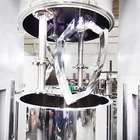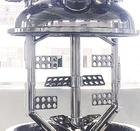Integrating development, manufacturing and sales, as a first-level mixer emulsifier factory.
Top 5 Mistakes to Avoid When Buying a Filling Machine: Financial & Strategic Mistakes
There are many types of filling machines, each designed to meet specific needs depending on the product and industry. With so many options, the buying process can feel overwhelming. But once you clearly define your needs, the decision becomes much easier.
Still, even when you know what you're looking for, it's easy to make mistakes—especially ones that can impact your production and finances in the long run.
In this article, we’ll walk you through the most common Financial & Strategic Mistakes people make when purchasing a filling machine. Our goal is to help you avoid these pitfalls with practical, straightforward advice. If you have specific questions or need tailored guidance, feel free to contact us via email or WhatsApp.
Buying a filling machine — or any production equipment — is a major investment for any company. That’s why it’s crucial to make informed decisions. A lack of preparation can turn that investment into a costly mistake.
Not Calculating Total Cost of Ownership (TCO)
For inexperienced or uninformed buyers, the purchase price seems like the final cost. But in reality, many additional expenses occur over the machine’s lifetime.
When we talk about Total Cost of Ownership (TCO), we mean considering all the following:
- Maintenance: Regular servicing and unexpected repairs
- Spare parts: Components that wear out or break
- Downtime: Losses from halted production when the machine is out of service
- Energy use: Electricity, fuel, or other resources the machine consumes
When you take a closer look at these costs, the “real” price of the machine becomes significantly higher — and ignoring that can lead to the next big mistake.
Choosing Based on Price Alone
No matter the size of your business, it's natural to look for savings when purchasing equipment — especially if you’re aiming for a fast return on investment. But choosing the cheapest option without evaluating long-term value can be an expensive mistake.
Here’s why:
- More Breakdowns
Cheaper machines are often built with lower-quality components, leading to frequent failures. Every breakdown costs time and money. - Poor Customer Support
Low-cost suppliers may offer limited service, slow repairs, and poor spare parts availability — making problems harder to solve. - Shorter Lifespan
A cheaper machine may wear out faster and need to be replaced sooner. In the end, you could spend more than if you'd chosen a better-quality option from the start. - Limited Scalability
Entry-level machines often lack the flexibility or features to support future growth. Upgrading or integrating them into a growing production line can be costly or impossible.
So instead of focusing only on the purchase price and choosing the cheapest option, you should ask:
- What’s the total cost of ownership over time?
(Including maintenance, spare parts, energy use, and downtime) - Is the machine reliable and well-supported?
(Strong customer support helps avoid long delays and hidden costs) - Will it meet our needs as we grow?
(Think about scalability, future features, and system compatibility)
The most cost-effective machine isn't always the cheapest. It's the one that offers reliable performance, long-term durability, and strong support — all aligned with your business goals.
Tip : Balance price with reliability, supplier reputation, after-sales service, warranty, and technical specs that match your real needs.
Important: Choosing the best option doesn't mean picking the most expensive one. It means choosing the machine that offers the best value — and one that you can afford to maintain.
Skipping ROI and Payback Period Analysis
Another common mistake is failing to calculate how long it will take for the machine to pay for itself and start generating profit.
This matters for two key reasons:
- ROI (Return on Investment): Measures how much value you gain compared to what you spent
- Payback Period: Tells you how long it takes for the investment to break even
If you skip these calculations, you risk:
- Buying equipment that locks up capital without contributing to business growth
- Missing better investment opportunities
- Struggling to justify costs when trying to scale or expand your business
Conclusion: Always Think Long-Term
Whether you're investing in a filling machine, a new vehicle, or another piece of equipment, long-term thinking should guide your decision.
Keep in mind:
- Look at the total cost over time, not just the sticker price
- Focus on value, not just cost
- Run the numbers to ensure the purchase supports your business strategy
In short: Invest smart. Think long. Grow strong.














































































































